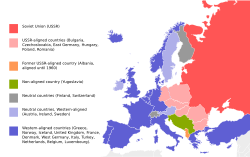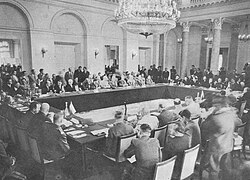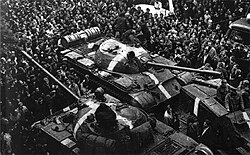Warsaw Pact
The Warsaw Pact, officially the Treaty of Friendship, Cooperation and Mutual Assistance, was an organization of Central and Eastern European states. The communist states were to be allies and to fight together if one of them was attacked. In theory, all of the countries in the organisation were equals, the smaller countries were controlled by the Soviet Union.[1] The countries in the Warsaw Pact were East Germany, Poland, Czechoslovakia, Hungary, Romania, Bulgaria and Albania. However, Albania withdrew in 1968 after the invasion of Czechoslovakia, and Romania followed.
| Treaty of Friendship, Cooperation and Mutual Assistance | |
|---|---|
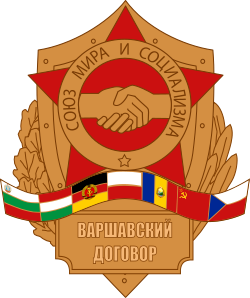 | |
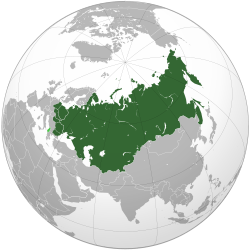 | |
| Abbreviation | WTO, WAPA, DDSV |
| Motto | Union of peace and socialism |
| Type | Military alliance |
| Headquarters | Moscow, Soviet Union |
| Membership | |
| Supreme Commander |
|
| Chief of Combined Staff |
|
| Affiliations | Council for Mutual Economic Assistance |
- Distinguish from the Warsaw Convention, which is an agreement about financial liability in air travel, and the Treaty of Warsaw (1970) between West Germany and the People's Republic of Poland.
It was established in 1955 in Warsaw, Poland, in response to West Germany joining the North Atlantic Treaty Organization (NATO). The treaty was signed in Warsaw, on 14 May 1955 and official copies were made in the languages of Russian, Polish, Czech and German. The Pact lasted until the end of the Cold War, when some members quit in 1991, following the collapse of the Eastern bloc and political changes in the Soviet Union.[2]
All of the Warsaw Pact countries and three that were part of the Soviet Union have joined NATO.
Members
Most member states were considered puppet states of the Soviet Union. Additionally, Mongolia, North Korea, Vietnam and (until 1961) China were observer states.
| Country | Status |
|---|---|
| Template:Country data People's Socialist Republic of Albania (until 1968) | Satellite state (until 1961) Independent (1961-1968) |
| Satellite state | |
| Satellite state | |
| Satellite state | |
| Satellite state | |
| Satellite state | |
| Satellite state (Until 1965) Independent (After 1965) | |
| Main contributor |
Warsaw Pact Media
The Presidential Palace in Warsaw, Poland, where the Warsaw Pact was established and signed on 14 May 1955.
A typical Soviet military vehicle UAZ-469, used by most countries of the Warsaw Pact
Meeting of the seven representatives of the Warsaw Pact countries in East Berlin in May 1987. From left to right: Gustáv Husák (Czechoslovakia), Todor Zhivkov (Bulgaria), Erich Honecker (East Germany), Mikhail Gorbachev (Soviet Union), Nicolae Ceaușescu (Romania), Wojciech Jaruzelski (Poland), and János Kádár (Hungary)
Soviet tanks, marked with white crosses to distinguish them from Czechoslovak tanks, on the streets of Prague during the Warsaw Pact invasion of Czechoslovakia, 1968
Protest in Amsterdam against the nuclear arms race between NATO and the Warsaw Pact, 1981
The Pan-European Picnic took place on the Hungarian-Austrian border in 1989.
A Romanian TR-85 tank in December 1989 (Romania's TR-85 and TR-580 tanks were the only non-Soviet tanks in the Warsaw Pact on which restrictions were placed under the 1990 CFE Treaty)
References
- ↑ "Warsaw Pact and NATO: Warsaw pact communiqué December 1971". Survival. 14 (2): 78–79. March 1972. doi:10.1080/00396337208441319. ISSN 0039-6338.
- ↑ Sardemann, Gerhard (2010-08-01). "Die Welt aus den Angeln heben". TATuP - Zeitschrift für Technikfolgenabschätzung in Theorie und Praxis. 19 (2): 8–17. doi:10.14512/tatup.19.2.8. ISSN 2199-9201.
Notes
- ↑ Withheld support in 1961 due to the Soviet–Albanian split, but formally withdrew in 1968.
